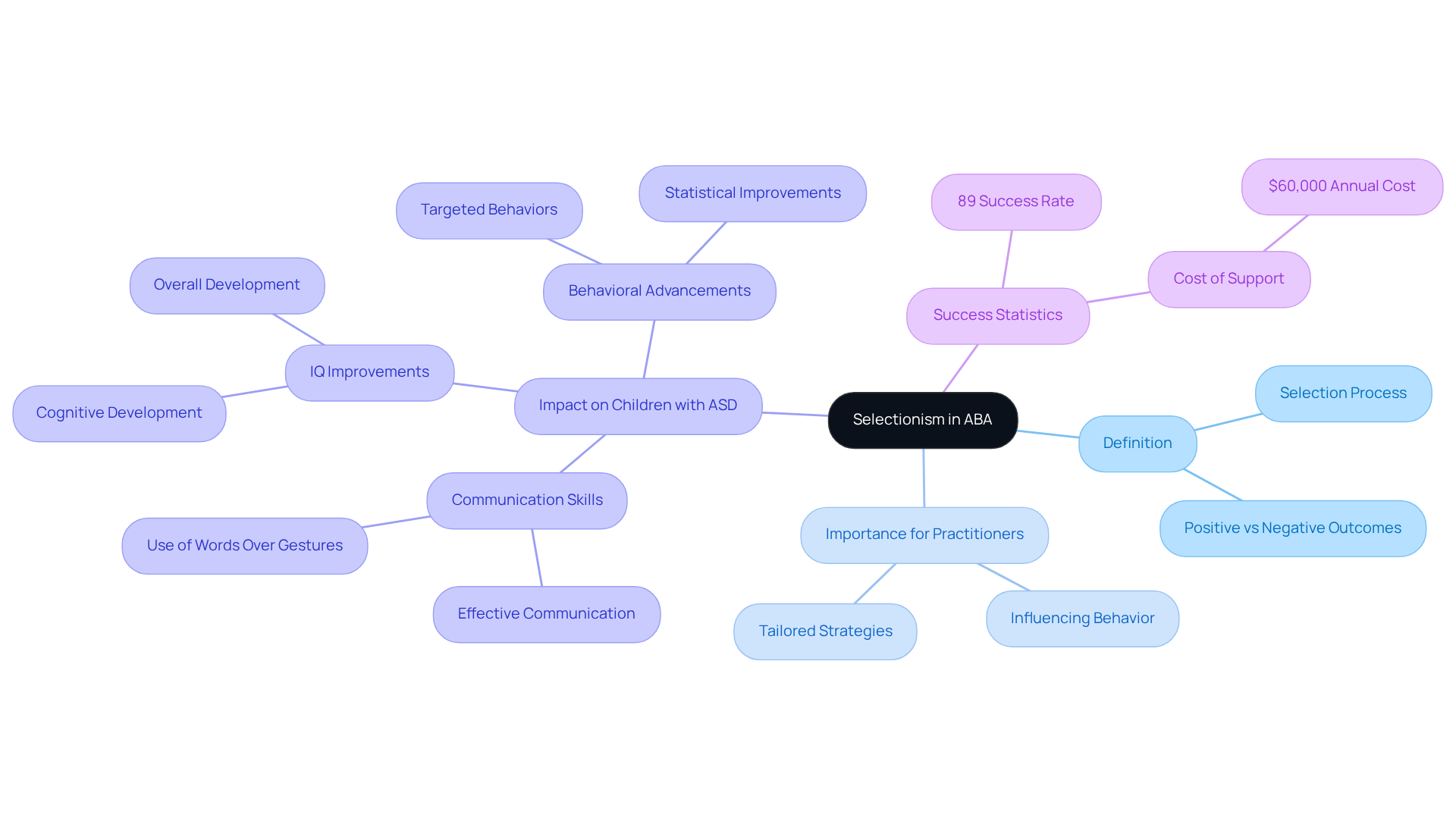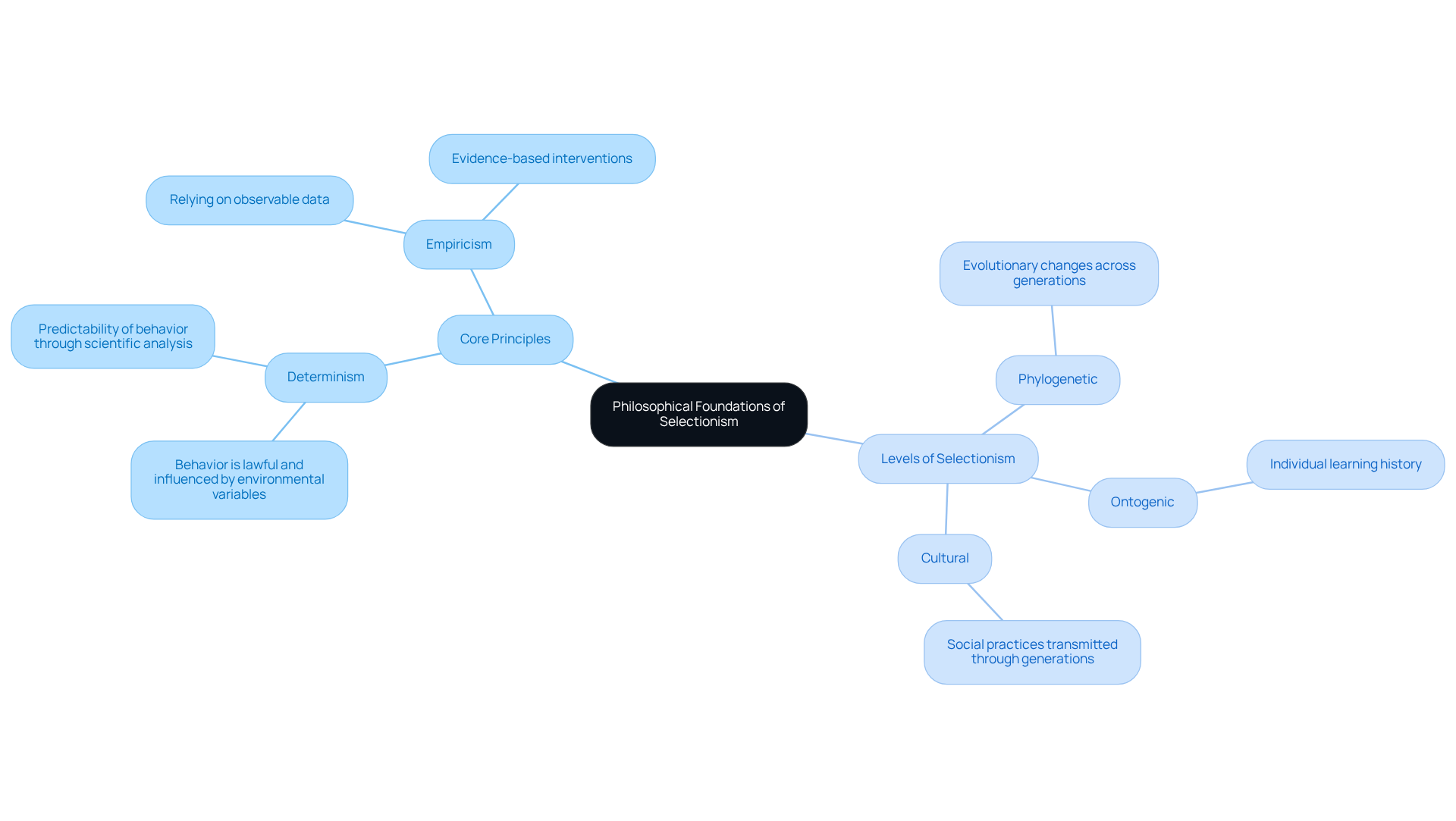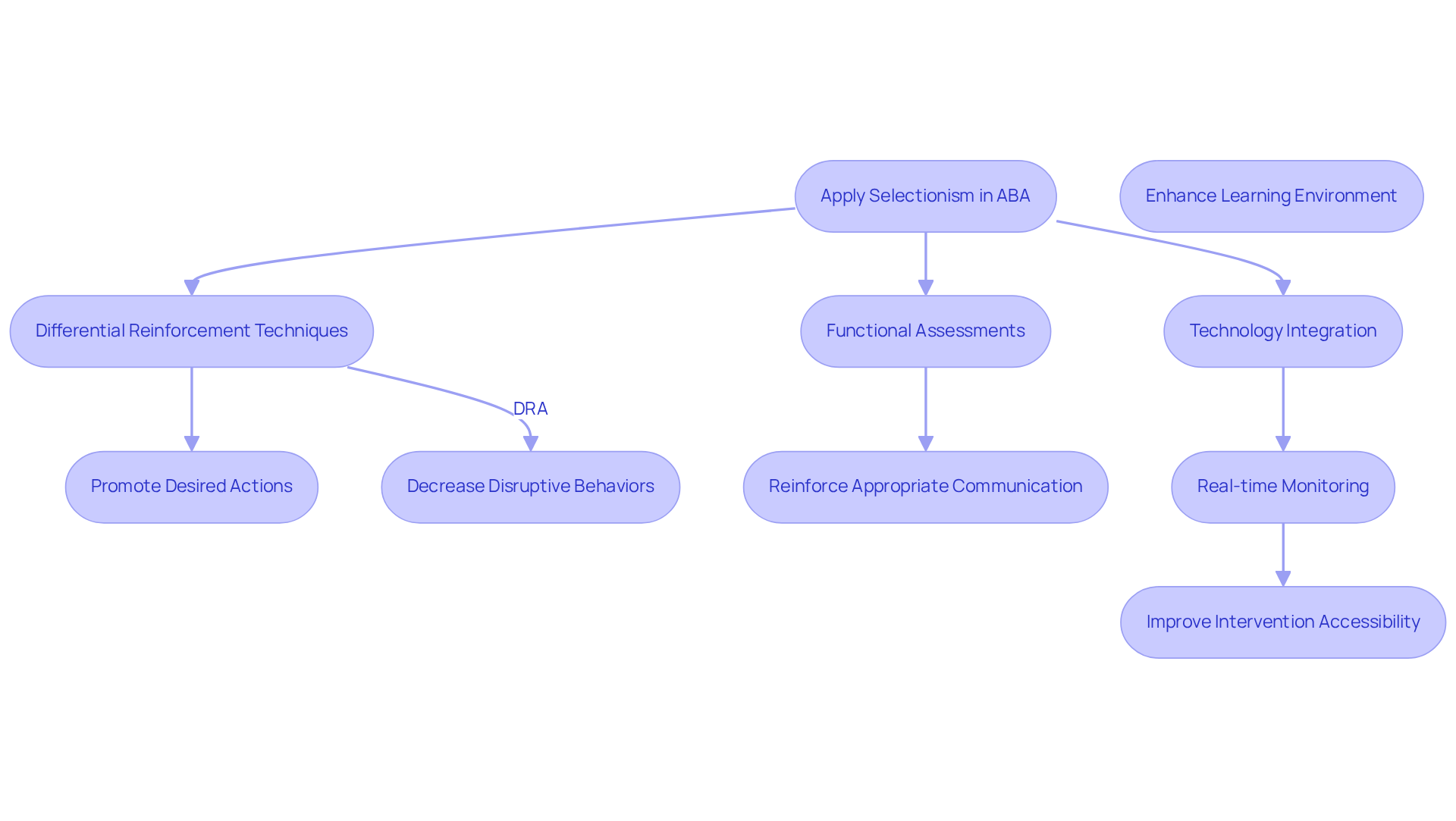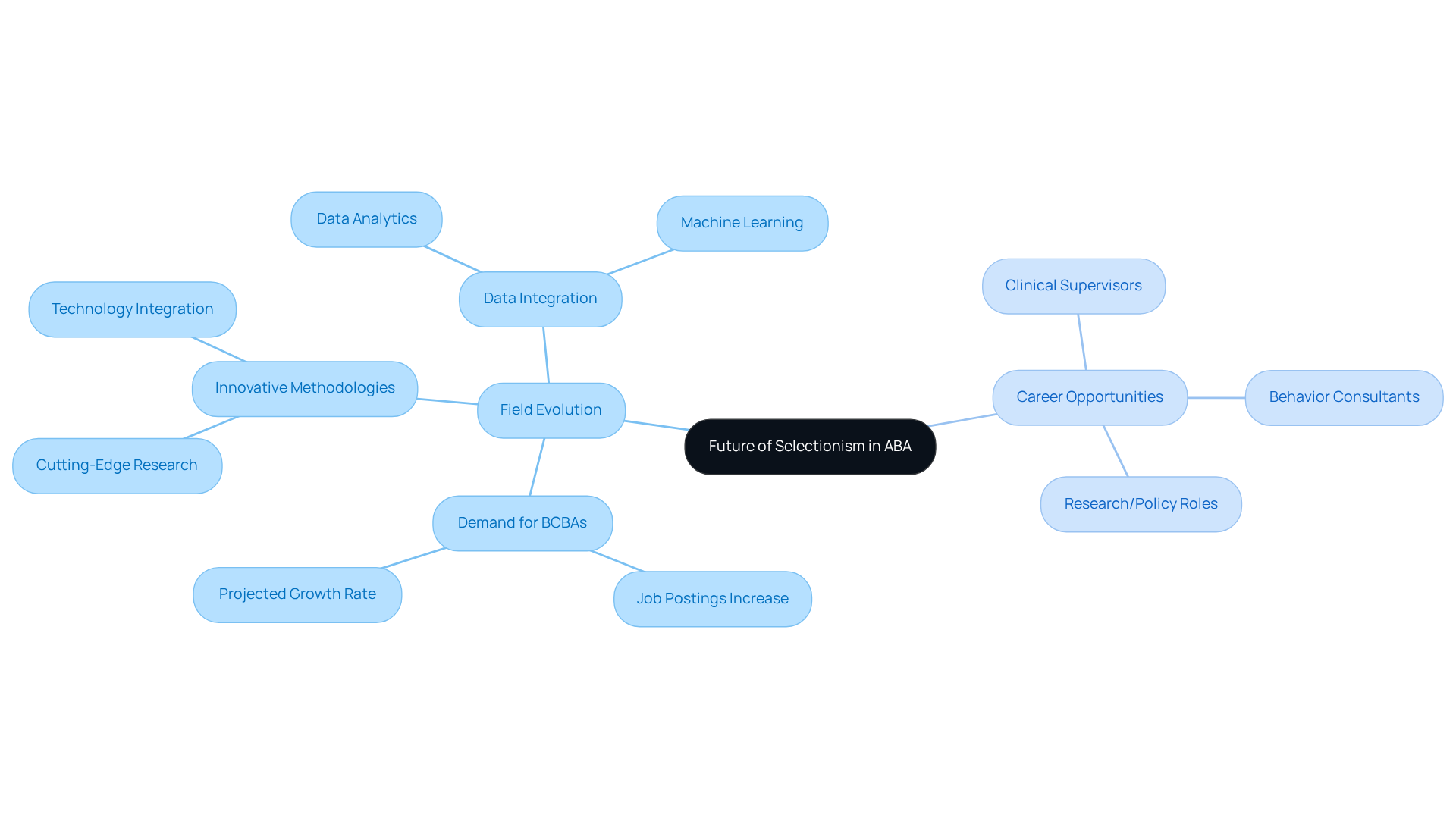September 19, 2025

The article delves into the concept of selectionism within Applied Behavior Analysis (ABA), underscoring its foundational role in understanding and modifying behavior through reinforcement based on outcomes. Selectionism is crucial not only for developing effective interventions for individuals with autism but also aligns with the burgeoning career opportunities in the field.
As the demand for behavior analysts continues to rise, driven by the proven effectiveness of ABA practices, understanding this concept becomes increasingly vital. This growing need presents an opportunity for professionals to enhance their skills and contribute meaningfully to the field.
Selectionism stands as a foundational principle in Applied Behavior Analysis (ABA), guiding practitioners in their quest to understand and modify behavior through outcomes and reinforcement. As the demand for Board Certified Behavior Analysts (BCBAs) continues to surge, it is crucial to explore the significance of selectionism within ABA.
This article highlights its theoretical underpinnings and practical applications that foster meaningful behavioral changes, particularly for individuals with autism spectrum disorder.
How can practitioners effectively integrate selectionism into their strategies to meet diverse needs and enhance outcomes? The evolution of the field necessitates a deeper understanding of this principle, ensuring practitioners are equipped to address the challenges they face in a dynamic environment.
Selectionism ABA stands as a cornerstone of Applied Behavior Analysis, asserting that actions evolve through a selection process shaped by their outcomes. This principle posits that actions resulting in positive outcomes are more likely to be repeated, whereas those leading to negative outcomes tend to fade.
For practitioners in selectionism ABA, understanding this concept is crucial for effectively influencing and modifying individual behaviors over time. Consider a child who learns to communicate more effectively by opting for words over gestures, driven by consistent reinforcement through positive feedback from caregivers. This method not only bolsters communication skills but also aligns with the compelling statistic that in enhancing various developmental aspects in children with autism spectrum disorder (ASD), including notable improvements in IQ scores, communication skills, and language abilities.
Furthermore, research indicates that autistic children receiving ABA treatment demonstrate statistically significant advancements in targeted behaviors within just one month. By grasping and applying the principles of selectionism ABA, behavior analysts can devise targeted strategies that foster meaningful behavioral changes, ultimately leading to improved outcomes for individuals with ASD.
As Frederick Strale Jr. aptly noted, "The only approaches demonstrated to yield thorough, enduring outcomes in autism have been grounded in the principles of ABA." This emphasizes the critical role of effective interventions like ABA therapy, particularly when considering the estimated annual cost of supporting an individual with autism, which is approximately $60,000.

Selectionism aba is grounded in several philosophical assumptions that significantly shape the practice of Applied Behavior Analysis. At the core of this framework are determinism and empiricism. Determinism asserts that behavior is influenced by prior events and environmental conditions, indicating that actions are not random but predictable based on observable influences. As Emmanuel Adekanla states, "Determinism is the belief that actions are lawful and influenced by environmental variables," underscoring the predictability of behavior through scientific analysis. In contrast, empiricism stresses the importance of relying on observable data to comprehend actions, ensuring that interventions are evidence-based rather than speculative. Adekanla also notes that "Selectionism aba is the foundation of all scientific work in ABA," emphasizing its vital role in effective practice.
Selectionism can be delineated into three distinct levels:
These foundational concepts illuminate the , demonstrating how various factors converge to shape individual behavior. For example, cultural selectionism elucidates how societal norms and values can influence behavior patterns within specific communities, highlighting the significant impact of environmental variables on actions. A pertinent case study is the development of social skills programs, where practitioners evaluate current research to devise strategies that address social issues, focusing on observable actions and ensuring treatment efficacy.
Current research continues to delve into these philosophical foundations, accentuating their relevance in cultivating effective practices in selectionism aba. By integrating determinism and empiricism into their methodologies, practitioners can devise strategies that are not only effective but also adaptable to the unique contexts of their clients, ultimately enhancing the efficacy of behavioral strategies.

In practice, selectionism ABA is effectively implemented through various interventions aimed at altering conduct. For instance, when engaging with children with autism, analysts frequently apply differential reinforcement techniques that promote desired actions while deterring maladaptive ones. This method exemplifies , as it operates on the principle that actions yielding positive outcomes are more likely to be repeated. Differential Reinforcement of Alternative Actions (DRA) is a prevalent technique where acceptable substitutes for problematic actions are reinforced, significantly decreasing disruptive behaviors by an average of 85% when the alternative action effectively serves the same function.
Moreover, practitioners utilize functional assessments to ascertain the precursors and outcomes of actions, enabling customized strategies that effectively encourage changes in conduct. For example, if a child engages in disruptive behaviors to gain attention, the analyst can adjust the environment to reinforce appropriate communication instead. This approach not only enhances the child's ability to express needs but also cultivates a more conducive learning environment. Current trends in ABA emphasize the integration of technology, such as mobile applications and wearable devices, which facilitate real-time monitoring and reinforcement delivery, making differential reinforcement strategies more accessible and precise.
Overall, the systematic application of differential reinforcement techniques in ABA practices not only supports the development of positive actions but also aligns with the growing recognition of the importance of personalized and culturally aware approaches in enhancing outcomes for diverse groups.

The future of selectionism aba in Applied Behavior Analysis (ABA) is exceptionally promising, underscored by a significant increase in demand for Board Certified Behavior Analysts (BCBAs). As the field evolves, it is crucial for analysts to embrace innovative methodologies that incorporate cutting-edge research and technology. Notably, the integration of data analytics and machine learning stands to revolutionize our capacity to predict and modify behaviors through selectionism aba principles.
This transformation is evident in the job market, where opportunities for BCBAs are expanding rapidly. By 2025, professionals will find diverse roles across clinical settings, educational institutions, and corporate environments. Positions such as:
will be readily available. The demand for qualified BCBAs is substantial, with a marked increase in job postings, reflecting a robust job market.
Understanding selectionism aba will be an invaluable asset for navigating these burgeoning career paths, aligning with the growing recognition of ABA's effectiveness in meeting behavioral health needs. Are you facing challenges in hiring qualified professionals? Hire ABA is here to support you in this competitive landscape. We offer that meticulously evaluate experience and career aspirations.
These assessments leverage advanced job fit scoring to match candidates with roles tailored to their skills and preferences, streamlining the job search process and enhancing the likelihood of finding suitable positions. Take action today to ensure you are equipped with the best talent in the field.

Understanding selectionism in Applied Behavior Analysis (ABA) reveals a profound framework for influencing behavior through the principles of reinforcement and environmental context. This foundational concept not only highlights the evolutionary nature of actions but also underscores the importance of evidence-based practices in fostering meaningful behavioral changes, particularly for individuals with autism spectrum disorder (ASD).
Throughout this exploration, key insights have emerged, including the significance of determinism and empiricism in shaping effective interventions. By employing techniques such as differential reinforcement, behavior analysts can effectively promote positive behaviors while reducing maladaptive ones. The philosophical underpinnings of selectionism, along with its practical applications, equip practitioners to create tailored strategies that enhance individual outcomes and adapt to diverse cultural contexts.
Looking ahead, the future of selectionism in ABA is bright. With increasing demand for qualified professionals and innovative methodologies that integrate technology and data analytics, the field is poised for growth. As the field continues to evolve, embracing these advancements will be crucial for behavior analysts aiming to meet the growing behavioral health needs. Engaging with selectionism not only prepares practitioners for a rewarding career path but also reinforces the vital role of ABA in transforming lives through effective behavior modification strategies.
What is selectionism in Applied Behavior Analysis (ABA)?
Selectionism in ABA is a principle that asserts actions evolve through a selection process influenced by their outcomes. Actions that result in positive outcomes are more likely to be repeated, while those leading to negative outcomes tend to diminish.
Why is understanding selectionism important for practitioners in ABA?
Understanding selectionism is crucial for practitioners as it enables them to effectively influence and modify individual behaviors over time, leading to meaningful behavioral changes.
Can you provide an example of selectionism in action?
An example of selectionism is a child learning to communicate more effectively by choosing words over gestures, motivated by positive feedback from caregivers. This reinforces the use of verbal communication and enhances communication skills.
What is the success rate of ABA therapy for children with autism spectrum disorder (ASD)?
ABA therapy has an over 89% success rate in improving various developmental aspects in children with ASD, including significant advancements in IQ scores, communication skills, and language abilities.
How quickly can advancements be observed in autistic children receiving ABA treatment?
Research indicates that autistic children receiving ABA treatment can demonstrate statistically significant improvements in targeted behaviors within just one month.
What is the estimated annual cost of supporting an individual with autism?
The estimated annual cost of supporting an individual with autism is approximately $60,000.
What did Frederick Strale Jr. say about the effectiveness of ABA?
Frederick Strale Jr. noted that the only approaches proven to yield thorough and enduring outcomes in autism are grounded in the principles of ABA, highlighting the critical role of effective interventions like ABA therapy.
Our expert recruitment strategies and AI-driven sourcing ensure that you receive top-notch candidates quickly, without compromising on quality. Whether you’re looking for BCBAs, Clinical Directors, or RBTs, we’ve got you covered.